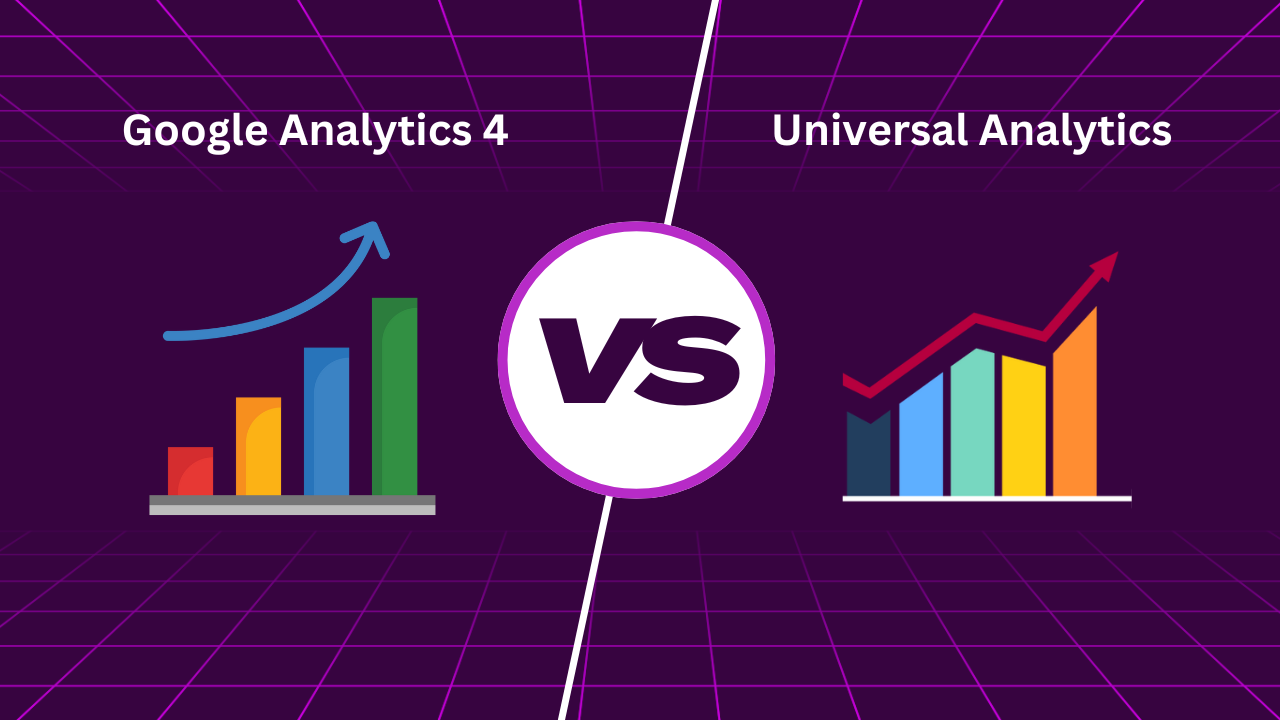The data processing for Google Analytics 4 vs. Universal Analytics properties will stop on July 1, 2023, despite the fact that you can still view any data previously processed for six months. Google Analytics 4 (GA4) is a replacement for UA. The new features, insights and AI technologies in Google Analytics 4 (GA4) make it an all encompassing analytics platform.
A summary of the many differences you can anticipate after your UA to GA4 conversion is finished is provided below.

Difference Between Google Analytics 4 vs. Universal Analytics
1. Reporting
- Total Users and New Users are the two user metrics that UA employs. Total Users, Active Users and New Users are the three user metrics that GA4 employs.
- While GA4 integrates online and app data in a single property, UA counts screen views in distinct mobile specific properties.
- UA supports the following five goal types: event goals, smart goals, pages/session, destination and duration. All events supported by GA4 are conversions.
- The percentage of sessions that were not engaged is known as the bounce rate in GA4. UA, Bounce rate is the proportion of users who visited one page throughout their whole session on your website and sent one request to the analytics server.
2. Tracking Code and Goals
- While GA4’s tracking code begins with G , UA’s begins with UA.
- GA4 uses events while Universal Analytics uses goals.
3. Objectives > Event Migration
- Use the “Google goals migration tool” at https://support.google.com/analytics/answer/10762548 to move existing goals.
- Destination goals and event goals are the only goals that may be migrated using the “Google goal migration tool”.
- Every custom tracking in GA4 can be manually developed, including bespoke revenue tracking from a booking engine.
4. E commerce and Data Comparison
Ecommerce marketing is supported by both UA and GA4, although there are differences in the configuration and implementation requirements.
The event based architecture of GA4 is built on the idea that each interaction can be recorded as an event. Pageview, event, social and transaction/e commerce property hit types are universal Analytics property hit types that convert to events in a Google Analytics 4 property.
5. Cross Platform
Limited cross device and cross platform reporting is available with UA, whereas complete cross device and cross platform reporting is available with GA4.
6. Machine Learning, AI and Data Retention
GA4 uses machine learning and AI technologies to deliver more sophisticated insights and predictive analytics. These functionalities are not available in UA. While GA4 has a 14 month data retention duration, UA has a 26 month period.
7. Funnel Visualisation
In addition, GA4 delivers a route analysis report that enables you to evaluate, segment and deconstruct user journeys. Funnel Visualization UA offers funnel visualization that backfills any skipped stages between the point at which the user entered the funnel and the step at which the user exited the funnel.
UA vs GA4: Data & reports
Not much has changed when comparing the information offered by Universal Analytics and Google Analytics 4. Although it could appear that GA4 has more user data, UA actually contains the same data; it’s only hidden beneath the “Audience” panel.
The terminology used for “engagement,” “monetization,” and the addition of “retention” are where there is the most contrast.
- Behavior has been replaced by engagement, which still includes many of the same topics but also includes reporting on conversions (formerly known as “goals”).
- On the other hand, monetization is a brand new beast that we shall discuss in more detail in this essay.
Over the past ten years there has been a rise in interest in keeping consumers and converting them into advocates. To emphasize its significance, Google has prominently shown retention reports in the Life Cycle report. Although there are currently few entries in this section of GA4, I anticipate there will be updates in the upcoming years.
Conclusion
There are major changes brought about by the switch from Universal Analytics (UA) to Google Analytics 4 (GA4). Better cross-platform reporting and funnel visualization are all features of GA4 in addition to improved reporting, tracking, and AI-driven insights. GA4 provides new concepts like engagement, monetization, and retention while maintaining some of the old data. Businesses now have the chance to use advanced analytics to gain a deeper understanding of their customers and the effectiveness of their websites. Google Analytics 4 vs. Universal Analytics. Upgrade for advanced insights, cross-platform tracking, and improved analytics capabilities.



